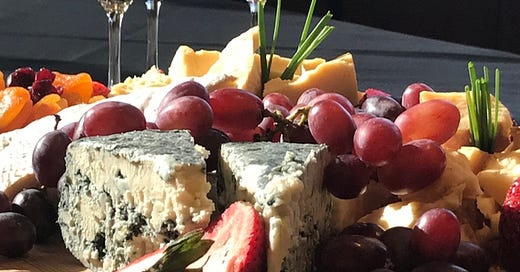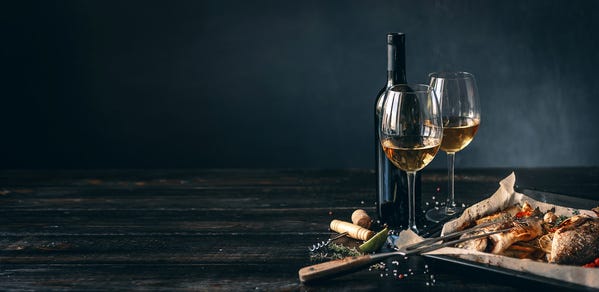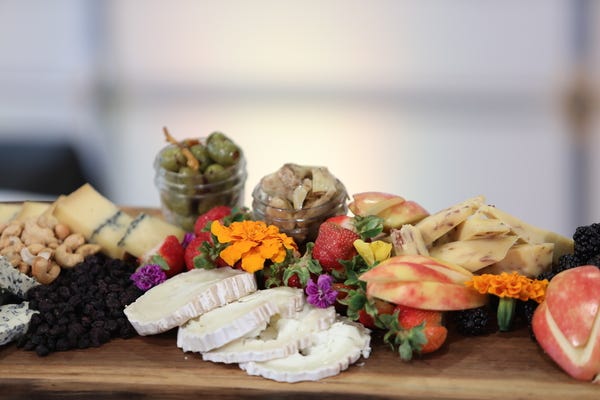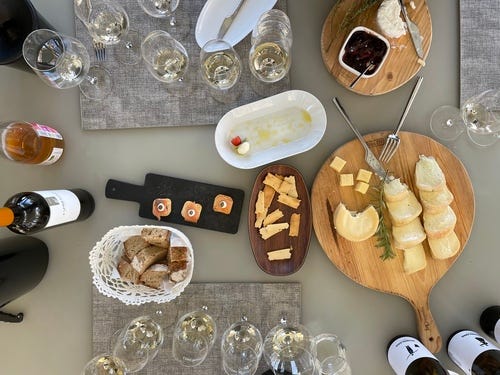I’ve been in the throes of teaching wine and food classes. Last Saturday, tonight, next Saturday… and, of course, next month’s Wine School series which will go deep on recipes, wine pairings, and party planning. I hope you will check it out.
Inevitably at these tastings someone always asks about wine and cheese. I get it. I’ve long championed apéro (you can call it aperitivo, cinq-et-sept, cocktail hour, whatever you prefer) as the prime time for hosting. It’s far less fussy than a dinner party, ritzier than a luncheon, and all you really have to do is unwrap a hunk of good cheese and pop the cork on some bubbly.
A wine and cheese in the late afternoon or early evening is seamless, simple, and stylish. Until you stress out about what wine and what cheese. Below, I’ve outlined four groupings for stylized cheeseboards and the wines that will work best with each.
Before we kick that wine-pairing hornets’ nest (I do have some unfortunate news – please don’t shoot the messenger), I wanted to give myself a leg-up to counter any potential knock downs. I’ve got some exciting bottles to share with you.
I’ve been wine shopping on overdrive these last few days. My sommelier services company, The Wine Sisters, has a number of events booked. The infamous PDAC conference rolls into Toronto this week, and thousands of people – tens of thousands, potentially – from around the world descend into the city looking to do business and hob-nob in a serious fashion. Wine tastings are among the choice activities for the critical elbow rubbing. And so, it’s off to work I go.
These are a few bottles I’ve picked up for tasting at various parties. Please note the pricing and availability is for Ontario, so what your local wine store has in stock may be different, as well as the pricing. Also note, this is not a sponsored list, but I sure as heck wish it was.
Querciabella “Mongrana” 2021 Maremma, Tuscany, Italy $24.95 #13653
Ever since becoming a somm, I have loved the Querciabella winery. Starting with one hectare in 1974 (relatively late for an Italian vineyard) the father-son business now boasts 100 hectares across the Tuscan hillside. Adopting organic practices in the 80’s then biodynamic and plant based in the early 2000’s this is a winery of extreme dedication to quality. Mongrana is a blend of Sangiovese with Cabernet Sauvignon and Merlot that’s been aged for 10 months in concrete vats. This aging process allows for development of complexity due to the small exchange of oxygen that concrete allows but keeps the fruit fresh as there is no oak to influence the flavours. All of this is to say, it should be an exciting and interesting addition to your dinner table. And a heckuva deal.
Château Bourdieu No. 1 2019, Côtes de Baye, Bordeaux, France $23.95 #21095
Hailing from the right bank of Bordeaux, this is mostly Merlot with less than 10% Cabernet Sauvignon and Malbec blended in. The exciting part for me is that 2019 is considered a top vintage, which means there are great deals to be found if you know where to look. And X marks the spot. Bordeaux has become so famous that it’s out of range for most of us. Even if the wine bottles are attainable, the $1,000+ price tags are not. But when Mother Nature blows a nifty little vintage our way, wines from so-called “lesser” appellations can be a real boon.
François Villard “Mairlant” Syrah 2020 St Joseph, Rhône, France $48.95 #35942
Another winemaker I’m a huge fan of, I was first introduced to Françoise Villard with his excellent, and stunningly good value Syrah, L’Appel des Sereines (which was selling at the time for $17, but inflation has boosted that to about $20.) He started out as a chef, but ventured into winemaking in 1991 and has since become one of Rhône’s rockstars. Using lots of innovative, old-is-new again wine making techniques, he aims for bright, energetic wines of poise.
Red Wine is C’est Dommage with Fromage. Sorry.
Here’s the dirty little secret no sommelier wants you to know:
Most of the time, what you’re eating and what you’re drinking… is fine.
Oh, sure, we want you to think that we’ve got that special know-how, that elusive je n’est sais quoi, that magic fairy dust to selecting just the right bottle with just the right morsel, but really, 80 per cent of the time, your dinner and wine, will be… fine. Probably about 10 per cent of the time, your food and wine pairing will be absolutely abysmal, and 10 per cent of the time your food and wine will be euphoric, but, as already stated, more often than not, things will mostly work out.
But if you’re anything like my wine students, “fine” not a satisfactory answer. You want to know the exact match to Tuesday’s tacos and precisely what to pair with Saturday’s steak… and, your cocktail hour cheeseboard.
Well, truth seekers, you may want to sit down for this.
Red wine, especially those rich, powerful, firm, and tannic reds, don’t work with cheese. Reds, thanks to that astringent tannin and heft, usually overpower cheese. Meanwhile, rich cheese often kills the complex nuances of the wine.
Trust me, I wish it weren’t true. That POV has not gained me any friends. And just like the cheese, I do not like to stand alone.
But I was vindicated last week, when, reading The New York Times Book of Wine: More Than 30 Years of Vintage Writing – a collection of essays from the 1970’s onwards – I found an article written by Florence Fabricant in July 1999 titled, Why Red Wine and Cheese Have Stopped Going Steady. In it, the esteemed food writer quotes no less than six sommeliers, winery owners, and food historians from both America and France, who all champion white wine as the better pairing for cheese.
It’s true: white wine’s bright acidity balances the fat of the cheese, while the creamy dairy rounds out the crisp edges of the wine.
Now, red wine disciples, not all hope is lost. This hard truth is not to say you can never enjoy red wine with cheese, you just want to be more considered in your cheeseboard curation. (This sounds more tedious than it actually is, I promise.)
Search “how to make a cheeseboard” and you will get back 181,000,000 results in 0.38 seconds.
Admittedly, I haven’t searched all 181,000,000 posts, but the ones I did scan (limited to the first page), basically all recommend a selection of five cheeses in the styles of hard, firm, semi-soft, soft, and blue. A generous selection to be sure, and one that will please your guests. But, speaking from a sommelier perspective, that mixed bag is a circus for wine pairing – white or red.
Sure, you can pop the cork on a bottle of dry bubbly no matter what you’re eating and leave it at that. No one will be mad – least of all me. But if your goal, like so many of my wine students, is to maximize the wine pairing for your cheese, the something-for-everyone cheeseboard of internet wisdom will not yield the results you seek.
For my wine and cheese parties I organize a board around a theme, usually something for the seasons; I’ve outlined some below and you are more than welcome to steal them as your own. I find it easier, and neater, quite frankly, to curate cheeseboards of a specific style – say light and gooey in summer, or strong and salty in winter, to help focus my wine pairing.
Light or Effervescent White Wines
Wines in this style have crisp acidity and citrus and mineral flavours. They include Champagne and dry traditional method sparkling wines, Vinho Verde, Muscadet, Sauvignon Blanc, Pinot Grigio, Assyrtiko, and dry Riesling.
These wines are easiest and most accommodating to pair. Their mouth-watering acidity helps cleanse the palate from the rich cheese, while the fat smooths the snappy acidity in the wine. Meanwhile, the salt in the cheese brings out the fruity flavours in the wine.
If push came to shove, you could make this wine style work for any of these cheeses listed here.
Brie
Camembert
Delice de Bourgogne
Feta
Young Manchego
Young Pecorino
Taleggio
Burrata
Rich or Spicy Whites
These are medium- to full-bodied white wines with creamy texture, such as oak-aged Chardonnay, Pinot Gris, Viognier, Gewürztraminer, Chenin Blanc, or Sémillon.
The lush texture of these white wines, along with their intense flavours, require cheese pairings of equal density. The acidity in these wines, while not as bright as the whites listed above, still bring a liveliness to the pairing. The cheeses below make a fantastic fall board – both for colour and weight.
Mimolette
Wildwood (Appenzeller-style cheese made in Ontario)
Tommes (eg. Tomme de Savoie or Tomme aux Fleurs)
Piave
Raclette
Gouda
Abondance
Époisses
Light, Juicy Reds
These wines are pale ruby in colour, with upfront, juicy fruit, low tannin, and medium-high acid. Gamay, Pinot Noir, Crianza-level Rioja, basic Chianti, Frappato, or Barbera d’Asti all fall into this category.
If you insist on red wine, this is the better style to maximize your pairing potential. Their bitter-tart red fruit flavour of cranberry, pomegranate, and Bing cherry, brings some liveliness to the pairing, so I like to use these reds with cheeses where I also might add a strawberry compote or cherry jelly to the cheese board.
This is a fun pairing to serve when the weather starts to hint at spring, as it is now – there’s still a nip in the air, if not snowflakes, but we’re desperate to celebrate the warmth.
Grey Owl
Morbier
Chèvre
Emmental
Taleggio
Comté
Full Bodied, Powerful Red
We need to tread carefully here.
Wines such as Amarone, Barolo, Cabernet Sauvignon, or Syrah are certainly favourites amongst wine drinkers, but perhaps counterintuitively, their firm tannin and high alcohol narrows the pairing options considerably. These wines are so muscular they can easily knock the lights out of a cheese, thereby ruining any chances for a satisfying pairing – and wasting the good money spent on fine cheese.
If you have members of your group – and we all do – who flat out refuse to drink anything other than a brawny red wine, you’re best to pair strong cheese, with piquant flavours and crumbly texture.
The following cheeses make great winter boards in the late fall and winter – the hearty, soul-soothing character the cheese quells our cozy cravings, and the robust wines bring heart-warming solace.
Old cheddar
Aged Manchego
Stilton
Gorgonzola
Parmesan
Pecorino (including those flavoured with truffle)
Asiago
Mature Castelmagno
PS–
Thanks for all your kind words with the launch of Quaintrelle. Your support and encouragement mean more than you know, and I’m grateful to have you along for the journey.
I love hearing from you, so please leave a comment, reply to this post, and if you think there is a wino or foodie in your life who might enjoy this community, please share it as well.
You could also follow me on Instagram if you want to see what I get up to everyday (mostly cooking and drinking, but still.)
xo-
Erin











Yay! Thank you for this! I take my WSET level 1 today- and the food pairing is what I find trickiest. I’ve had to throw out older ideas and it’s been eye opening! I knew red wine and blue cheese just didn’t go together, no matter how badly I wanted them to. Luckily, champagne pairs well with an awful lot, and makes for an easy, fun apero.
Fun and helpful read!
Great read on the wine and cheese pairing. I live in a rural community in Northumberland County (east of the GTA) - and access to some of these cheeses is tricky. But I will definitely refer to this when planning my next cheese board. Now I just have to get my full bodied, red wine loving husband to get on board with the whites!